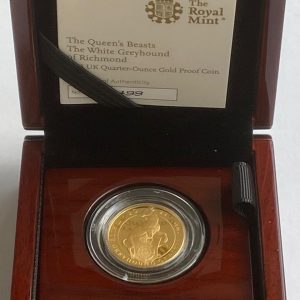- Sorry, this product cannot be purchased.
2017 Queens Beasts English Lion Gold Proof Quarter Ounce
Call for price
The 2017 Queens Beasts English Lion Gold Proof Quarter Ounce.
Both the Obverse and Reverse was designed by Jody Clarke.
Fineness: 24 carat gold (999.9).
Weight: One-quarter troy ounce (7.80g).
Diameter: 22.00 mm.
Denomination: £25.
Description
2017 Queens Beasts English Lion Gold Proof Quarter Ounce
General Description: The Queen’s Beasts Series
The Queens Beasts is a series of 10 designs issued by the Royal Mint to represent the ten heraldic statues that were present at the coronation of Queen Elizabeth II. The coins are issued in Proof/Bullion as silver, gold and platinum and in a wide range of weights and denominations. The release is planned from 2016 through 2021.
Gold is issued as 5oz, 1oz, ¼oz (denominated £500, £100, £25).
Silver is issued as 1kg, 10oz, 5oz, 2oz, 1oz (denominated £500, £20, £10, £5, £2).
(The year is that of the first release of that design)
| Year | Beast | Description |
| 2016 | Lion of England | The crowned golden lion of England. It has been on the Royal Arms sine Edward IV (1461-1483). |
| 2017 | Griffin of Edward III | The Griffin is an ancient mythical beast. It signifies courage and strength combined. |
| 2017 | Red Dragon of Wales | The Red dragon was the badge of Owen Tudor. The story derives from the dragon on LLewelyn the Last’s castle grounds. |
| 2018 | Unicorn of Scotland | Two unicorns were adopted by the Scottish Royal Arms back i the 16th century, eventually passing to England via James VI of Scotland who became James I of England. |
| 2018 | Black Bull of Clarence | The Black Bull derives from Edward IV. |
| 2019 | Yale of Beaufort | The Yale was a mythical beast, supposedly white and covered with gold spots and able to swivel each of its horns independently. It descends to the Queen through Henry VII. The portcullis is also a Beaufort badge. |
| 2019 | White Lion of Mortimer | The White Lion of Mortimer derives from Edward IV. The shield shows a white rose encircled by a golden sun, known heraldically as a ‘white rose en soleil’. |
| 2020 | White Greyhound of Richmond | The White Greyhound of Richmond was a badge of John of Gaunt, Earl of Richmond, son of Edward III. Also used by Henry IV and Henry VII. The Tudor double rose is on the shield, one rose within another surmounted by a crown. |
| 2020 | Falcon of the Plantagenets | The falcon was first used by Edward III of the House of Plantagenet as his badge and descended to Edward IV. |
| 2021 | White Horse of Hanover | The White Horse of Hanover was introduced into the Royal Arms in 1714 when the crown of Great Britain passed to George I. |
Which Mint: The Royal Mint
The Royal Mint is the designated place for the UK to mint coins. It dates back well over 1000 years and is a Government-owned company.
Formed in the reign of Alfred the Great about the year 886, it moved to the Tower of London in 1279 and remained there for over 500 years. The Master of The Royal Mint has included famous figures such as Sir Isaac Newton. Since 2010 it has operated as Royal Mint Ltd, a company owned by HM Treasury, under an exclusive contract to supply all coinage for the UK although it also produces medals and coins for other countries. It is currently located at Llantrisant, Wales.
The Monarch: Elizabeth II (1952-)
Queen Elizabeth II is the current and longest reigning monarch ever. Born on 21 April 1926 to King George VI and Elizabeth Bowes-Lyon, she became Queen in 1952 and her Coronation was on 2 June 1953.
Queen Elizabeth II has issued many coins and was monarch during decimalisation.
Country of Origin: United Kingdom
The United Kingdom (UK) is the Union of England, Scotland, Wales and Northern Ireland. It is often refered to as Great Britain (GBR). It has a long, rich history.
It’s original coinage was Pounds, Shillings and Pence but since decimalisation on 15 February 1971, it is £1 = 100p, that is One Pound = 100 pence. The coinage of the UK is also a long history, the Royal Mint being established as long ago as 886AD when coins were hammered. Today there is perhaps 30 billion coins in circulation, and many (numismatic) collectors coins and sets are issued frequently in gold, silver and other metals.






